
Ducati Diavel Owners Manual: Charging the battery
Before charging the battery, it is recommended to remove it from the motorcycle.
 Important
Important
The battery is housed in the cowling, always contact a ducati dealer or an authorised service centre for its removal.
Remove the left cowling (1, fig. 137) Loosening: side screw (2, fig. 137) Retaining the electrical parts box; top screw (3, fig. 137) Retaining the electrical parts box; bottom screw (4, fig. 137) Retaining the central cowling;
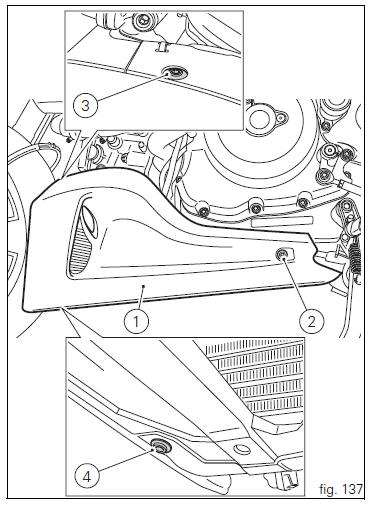
Screw (5, fig. 138) Retaining the central cowling to left cowling.
Unscrew the screws (6, fig. 139) And remove the battery mounting cover (7, fig. 139).
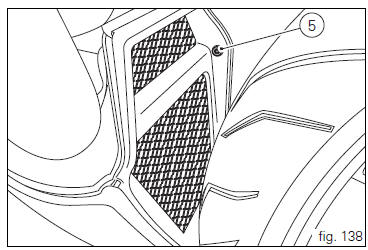
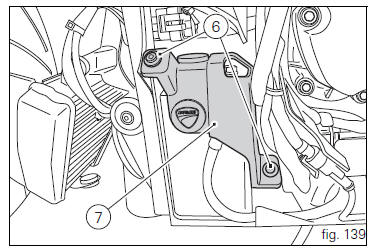
Slide out the battery (8, fig. 140) From its housing and, always starting from the negative terminal (-), loosen the screws (9, fig. 140).
Remove the positive cable (10, fig. 140), The abs positive cable (11, fig. 140) From the positive terminal and the negative cable (12, fig. 140) From the negative terminal.
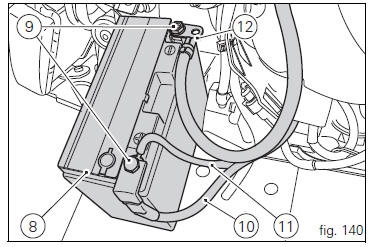
 Warning
Warning
The battery produces explosive gases: keep it away from heat sources and flames.
 Warning
Warning
Keep the battery out of the reach of children.
Charge the battery at 0.9 A for 5÷10 hours.
Charge the battery in a well-ventilated area.
Connect the battery charger leads to the battery terminals: red to the positive terminal (+), black to the negative terminal (-).
 Important
Important
Connect the battery to the charger before switching it on; failure to do so can result in sparking at the battery terminals, which could ignite the gases inside the cells.
Always connect the red positive terminal (+) first.
Lay down the abs positive cable (11, fig. 141), Onto positive cable (10, fig. 141) And start screw (9, fig. 141) In its thread on these cables.
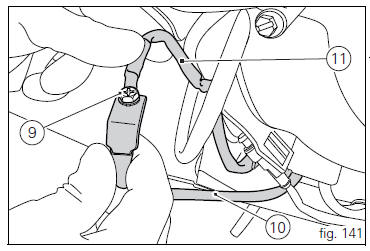
Connect the positive cable (10, fig. 142), Previously assembled to abs cable (11, fig. 142), To battery positive terminal, and negative cable (12, fig. 142) To battery negative terminal, by starting the other screw (9, fig. 142) In its thread.
Tighten the terminal clamp screws (9, fig. 142) To a torque of 5 nm ±10% and apply grease onto the battery terminals to prevent oxidation.
Reposition the battery (8, fig. 143) In the support, positioning the cables (10, fig. 143) And (11, fig. 143) As shown in fig.
143.
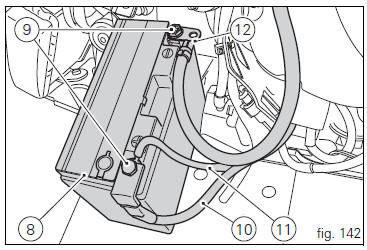

Refit battery mounting cover (7, fig. 144) And fasten tightening the screws (6, fig. 144) To a torque of 10 nm ±10%.

Refit the left cowling (1, fig. 145) As follows: start the side screw (2, fig. 145) Retaining the electrical parts box in its thread; start the top screw (3, fig. 145) Retaining the electrical parts box in its thread; start the bottom screw (4, fig. 145) Retaining the central cowling in its thread;

Start the screw (5, fig. 146) Retaining the central cowling to left cowling in its thread.
Tighten the screws (2, fig. 149), (3, Fig. 145), (4, Fig. 145) And (5, fig. 146) To a torque of 10 nm ±10%.

 Adjusting throttle control free play
Adjusting throttle control free play
The throttle twistgrip must have free play of 1.5×2.0 Mm in
all steering positions, measured on the outer edge of the
twistgrip. If necessary, adjust it using the adjusters (1 and 2,
fig. 135 ...
 Charging and maintenance of the battery during winter Storage
Charging and maintenance of the battery during winter Storage
Your motorcycle is equipped with a connector (1, fig. 147) To
which you can connect a special battery charger available
from our sales network.
...
Other materials:
Clutch cover
Clutch-side crankcase cover
Screw
Screw
Oil level sight glass
Screw
Plate
Bush
Sealing ring
Shim washer
Circlip
O-ring
Locating bush
O-ring
Plug
Sealing washer
Screw
Plug
Panel
Spare parts catalogue
Diavel abs clutch-side crankcase cover
Diavel carbon
a ...
Injection and ignition
Introduction
Ignition is via a single stick coil per cylinder installed in the spark plug
well. Each thermal unit is supplied by a single
injector, placed under the throttle valve. The amount of fuel injected and the
ignition advances are determined by the
control unit specifically for each c ...
Lubricating cables and joints
Check the outer sheath of the throttle control and cold start
lever cables for damage at regular intervals. The outer plastic
cover should not be flattened or cracked. Operate the
controls to make sure the inner cables slide smoothly inside
the outer sheath: if you feel any friction or catching, ...